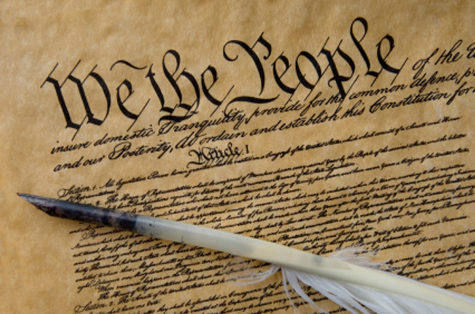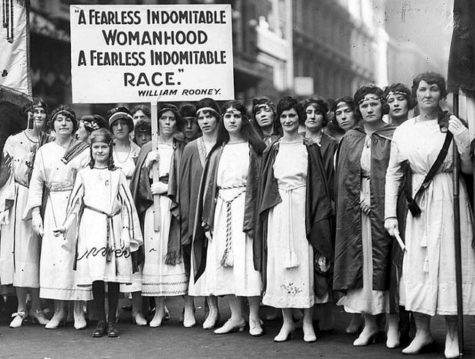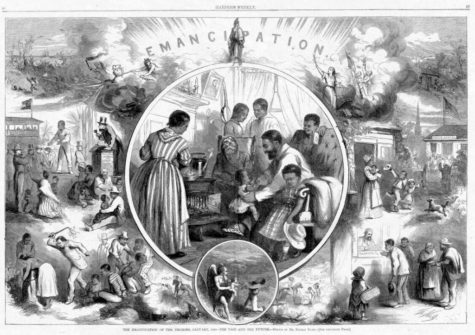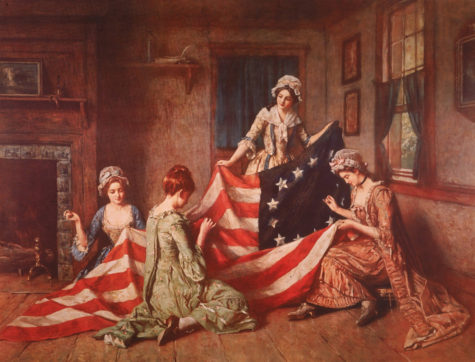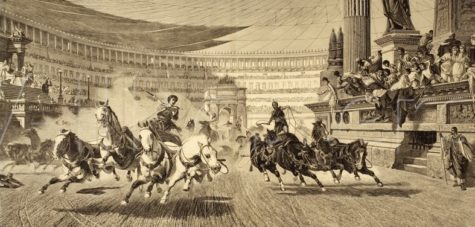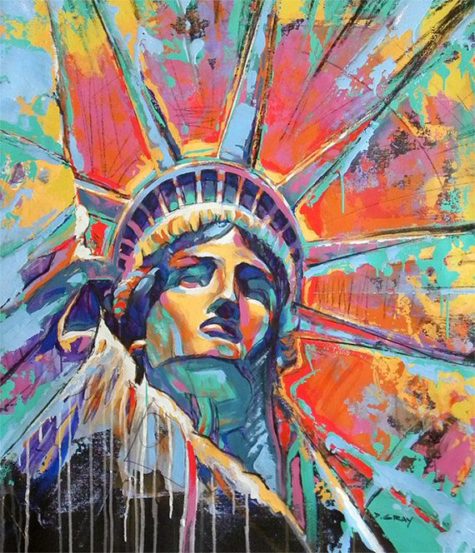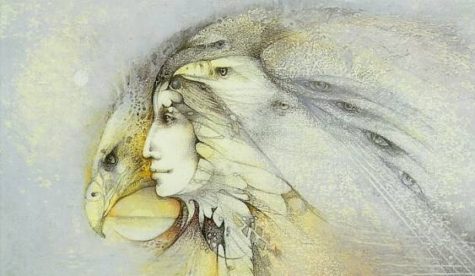Freedom
Formerly called “I am an American Day” (1940) and then “Citizenship Day” (1952), this observance’s long new name (2004) is called Constitution Day for short. Celebrated on Sept 17 , it marks the anniversary of the date in 1787 when the final draft of the Constitution of the United States was signed by delegates to the Constitutional Convention after months of wrangling.
The framers of the Constitution had been arguing constantly as they met in secret, but they had leaked reports to the press indicating that all was well. “So great is the unanimity, we hear, that prevails in the convention, upon all great federal subjects, that it has been proposed to call the room in which they assemble ‘Unanimity Hall.'” The Federalists (as they came to be called) argued through June and most of July and reached an agreement on July 16.
After deciding to leave out a bill of rights — because everyone was worn-out and they thought there was no need for such a list — the framers completed the final draft on September 17 and made it ready for submission to the states for ratification.
The American Bar Association and other organizations make an effort to mark this anniversary by sponsoring symposia and, in some cases, offering free legal advice.
From: Almanac.com
Formerly known as Woman Suffrage Day, August 26 marks the ratification of the 19th Amendment to the U.S. Constitution (1920), granting women the right to vote. Ratification came in Tennessee, where suffragist (Anitia) Lili Pollitzer, age 25, persuaded Tennessee state legislator Harry T. Burn, age 24, to cast the deciding vote.
“I know that a mother’s advice is always safest for a boy to follow,” he said, “and my mother wanted me to vote for ratification.”
The country’s 26 million voting-age women were enfranchised by this change in the Constitution. Longtime suffragist Carrie Chapman Catt summed up her experiences in the battle this way: “Never in the history of politics has there been such a nefarious lobby as labored to block the ratification.”
Upon ratification, Catt founded the League of Women Voters, an organization now dedicated to providing impartial, in-depth information about candidates, platforms, and ballot issues.
From: Almanac.com
A great recipe to celebrate Independence Day in the United States:
- ¾ cup sour cream
- 1/4 tsp. coarse black pepper
- 1 tsp. white sugar
- 1 tbsp. rice wine vinegar
- 1 tsp. fresh chopped dill
- 1/8 tsp. fresh grated lemon peel
- 1/4 tsp. finely grated red onion
- salt
- 1 cucumber
- 3 garden fresh red tomatoes
- 10 borage flowers
Combine all the ingredients except for the tomatoes and flowers. Slice tomatoes and arrange them, overlapping, around the edge of a serving platter. Mound the cucumber mixture in the center of the platter, just covering the inner edge of the tomatoes. Chill well, and place the borage flowers decoratively on the salad just before serving.
Serves 4 to 6
Recipe by Di-Di Hoffman
July 1st is Canada Day, a holiday that marks Canada’s independence from Great Britain which took place in 1982.
There is no standard mode of celebration for Canada Day; Jennifer Welsh, a professor of International Relations at the University of Oxford, said about this: “Canada Day, like the country, is endlessly decentralized. There doesn’t seem to be a central recipe for how to celebrate it—chalk it up to the nature of the federation.
Most communities across the country will host organized celebrations for Canada Day, typically outdoor public events, such as parades, carnivals, festivals, barbecues, air and maritime shows, fireworks, and free musical concerts, as well as citizenship ceremonies.
However, the locus of the celebrations is the national capital, Ottawa, Ontario, where large concerts and cultural displays are held on Parliament Hill, with the governor general and prime minister typically officiating, though the monarch or another member of the Royal Family may also attend or take the governor general’s place.
Source: Wikipedia
Emancipation Day, also called Juneteenth, celebrates the end of slavery and freedom on June 19, 1865 in eastern Texas and portions of the surrounding states. On that day, General Gordon Granger landed with Federal troops in Galveston, Texas, with the intention of enforcing President Abraham Lincoln’s Emancipation Proclamation of January 1, 1863.
The end of slavery was a gradual process, occurring as news of the proclamation reached outlying towns and states. Juneteenth was probably a shortened version of June 19th. A proclamation from the president stated that all slaves were now free, and the relationship between master and slave was now employer and employee:
“The freedmen are advised to remain quietly at their present homes and work for wages. They are informed that they will not be allowed to collect at military posts and that they will not be supported in idleness either there or elsewhere.”
Beginning the year following this Texas event, 1866, large celebrations to rival the Fourth of July began, including prayer services, inspirational speakers, reading of the Emancipation Proclamation, storytelling by former slaves, and traditional food and games. Soon neighboring states such as Louisiana, Arkansas, and Oklahoma were adding celebrations. Throughout Texas, ex-slaves purchased land for their Juneteenth gatherings.
June 19 was declared a legal holiday in Texas in 1980.
Whatever your ethnicity, it is always good to recognize that you have freedom – or if not, Juneteenth reminds you to work hard at obtaining it. If there are bonds tying you down, such as debt, addictions, or unwanted relationships, create a list that marks out a strategy that leads toward freedom.
Celebrating the Day:
- Wear white on Juneteenth – it is the color of spiritual strength.
- Fire is important.
- For dinner have a barbecue featuring your favorite foods.
- Be sure to include some tasty roasted tubers and root veggies like sweet potato and sweet onion.
- Have an extravagant soft drink. It is the tradition to have strawberry soda, but sparkling cranberry juice or berry flavored mineral water will do as well.
As the coals of the fire turn white with heat and the sun settles in the west it is time to turn to ritual. It is appropriate to purge things holding you down. Burn old unnecessary papers. Set yourself free from the past by clearing clutter. You’d be surprised how much this improves your mental health!
Sources: Almanac.com and Four Seasons of Mojo
What we know fondly as the “Stars and Stripes” was adopted by the Continental Congress as the official American flag on June 14, 1777, in the midst of the Revolutionary War.
Colonial troops fought under many different flags with various symbols and slogans–rattlesnakes, pine trees, and eagles; “Don’t Tread on Me,” “Liberty or Death,” and “Conquer or Die,” to name a few. The first flag had 13 stars on a blue field and 13 alternating red and white stripes for the 13 original colonies. Now there are 50 stars, one for each state in the Union, but the 13 stripes remain.
Although many people believe that Betsy Ross designed and sewed the first flag, there is no proof of that. Flag Day was first celebrated in 1877, on the flag’s 100th birthday.
From: Almanac.com
The Plebeian Games were an ancient Roman religious festival held November 4–17. The games included both theatrical performances and athletic competitions for the purpose of entertaining the common people of Rome.
The Ludi Plebeii comes from the two words ludi (meaning play, games, etc.) and plebeii (meaning a “pleb” or plebian: a commoner person as in comparison ta member of the royal or upper class). The Ludi Plebeii or Plebeian Games were an ancient Roman festival held from November (which is derived from novem or 9, because it was originally the ninth month of the year) 4th to the 17th.
The ludi or game factor of the festival was because this celebration had both theatrical performances( such as comedy, satire, tragedy plays) and athletic competitions (running, chariot racing,etc).
The importance of the Ludi Plebeii is because it represents one of the earliest national holidays of liberation. Similar to the United State’s Fourth of July or the French holiday Bastille Day, the Ludi Plebeii celebrated the plebeian’s political liberty. The Ludi Plebeii are thought to be the oldest public festival having been established roughly in 220 BCE. The great orator Cicero considered them Rome’s oldest Ludi.
The liberation that is being celebrated often varies from the tyranny of the Tarquins (an Etruscan Roman family whose history can be read on here ) or the suppression and dominance of the patricians (who were the ruling class of Rome in the struggle known as the Conflict of the Orders). Some historians even conjecture that the festival was celebrated before 220 BCE, but due to the lack of a religious calendar it was not recorded.
The dates vary for the happenings of the festival; however, they seem to follow a certain pattern:
During the Ludi Plebeii, the first ceremonial rite was a feast to Jupiter (Zeus) known as Epulum Iovis was held on November 13th (some sources say the Ides of November which is the 15th). This feast entitled the Senator to eat on the Capitoline as the public’s expense while the Roman plebeians or commoners dined in the Forum. Following the feast were several days of performance and games ( theses days vary from 9 of performance and 4 of games to smaller denominations). On the day of the Games, a great Pompa, or procession, led by statues of the Capitoline Triad, would proceed to the Circus, where Gods and men joined to watch the races. The games usually ended on the 17th of November.
A more scholarly description is as follows:
The Ludi Plebeii were, according to Pseudo-Asconius, founded to commemorate the freedom of the plebeian order after the banishment of the kings, or after the secession of the plebs to the Aventine. However, historic evidence does not support the first theory and it is likely that these games were instituted in commemoration of the reconciliation between the patricians and plebeians after the plebeians removed to either the mons sacer or, according to others, the Aventine.
The Ludi were initially conducted from November 16-18, overseen by the aediles plebis. The aediles were garbed in the robes of a triumphator, hinting at a link between the games and the ancient triumphal rites. They are almost certainly the oldest games extant, second only to the Ludi Romani held in September. Legend places the Ludi in the early history of Rome, however, the earliest mention by Livy sets the games in 216 BCE in the Circus Flaminius, built around 220 BCE and the latest record of the games can be found on the Calendar of Philocalus.
By 207 BCE the Ludi were celebrated over several days, and the Fasti Maffeiani, one of the most important surviving contemporary calendars from the Augustan era, sets the Ludi from 4-17 November.
The central focus of the Ludi was the Epulum Iovis, or feast of Iuppiter, on the Ides of November, this date being sacred to Him. The Senators ate at public expense on the Capitoline, while the Roman public dined in the Forum. The Epulum Iovis were preceded by nine days of theatrical performances and four days of racing in the Circus. On the day of the Games, a great Pompa, or procession, led by statues of the Capitoline Triad, would proceed to the Circus, where Gods and men joined to watch the races.
Titus Maccius Plautus (254-184 BCE) probably sold his first plays at the Ludi, and his play Stichus was first performed at the Ludi Plebeii. Plautus’ puns and slapstick humour were greatly valued by the Romans themselves (if not by the likes of Horace and Augustus) and influenced a much later playwright from the 16th Century: William Shakespeare.
The modern and beloved musical, A Funny Thing Happened on the Way to the Forum is inspired by Plautus and contains many of his characters, including Miles Gloriosus, the braggart soldier, Pseudolus, the wily slave, and Senex, the doddering oldster.
Sources:
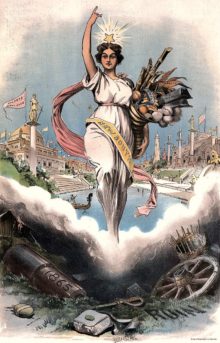 Commemorates the storming of the Bastille, which started the French Revolution, on July 14th, 1789. Bastille Day is also celebrated by many of France’s former and current colonies.
Commemorates the storming of the Bastille, which started the French Revolution, on July 14th, 1789. Bastille Day is also celebrated by many of France’s former and current colonies.
For A Magickal Bastille Day
- Theme: It’s time for a revolution!
- Colors: Blue, white, and red
- Symbols: The Eiffel Tower and the French national flag
- Presiding Goddess: Lady Liberty
About Lady Liberty:
Although, Lady Liberty is not a goddess in the true sense of the word, she is a potent symbol of freedom. The statue of Liberty was a gift to the United States from the people of France. The statue is of a robed female figure representing Libertas, the Roman goddess of freedom, who bears a torch and a tabula ansata (a tablet evoking the law) upon which is inscribed the date of the American Declaration of Independence, July 4, 1776. A broken chain lies at her feet. The statue is an icon of freedom. In 1793, during the French Revolution, the Notre Dame de Paris cathedral was turned into a “Cult of Reason” and for a time “Lady Liberty” replaced the Virgin Mary on several altars.
To do today:
Time to take stock of your life and circumstances. Is it time for a revolution in your life? Is it time to break down barriers, make new rules, give yourself permission to be free of oppressive situations and/or relationships? Is it time to draw up your own Declaration of Independence, or as the French termed it, the Declaration of the Rights of Man and of the Citizen?
Here is a spell for personal freedom:
This spell taps directly into the energy and power of Bastille Day, and can be performed any time it is needed. You will need a length of blue, white, and red ribbon or yarn. It should be as long as you are tall. You can use three ribbons, each a solid color, or one ribbon that is a combination of the three colors. You will also need an envelope, and a handful of dandelion fluff, or feathers, a small candle, and a knife or pair of scissors.
Light the candle, and then place the dandelion fluff into the envelope, and seal it shut. Those little bits of fluff or feathers represent your spirit. The envelope represents the walls you have created to protect yourself. Carefully fold or roll the envelope up so that will fit comfortably in your hand. You control your own destiny. It lies in your hands now.
Sit down, holding the envelope, and think about what restricts your freedom, what circumstances and situations starve your spirit, and steal your joy, what binds you, what constricts you, what holds you back. Begin to tie the ribbon around the envelope. There is no wrong way to bind up the envelope with the ribbon. Tie as many knots as you’d like. While you are binding the envelope, be thinking about the restrictions that bind your spirit. When you are complete, drip candle wax onto the bundle to seal it, and then snuff the candle.
Now, take the wrapped up envelope outside, along with the knife or scissors outside. Take a few moments to breathe in the outside air, listen to the sounds around you, notice the wind and the sky. You can be free. You can claim your freedom. Allow yourself to think about how it will feel to be free. When you are ready, begin to cut the strands of ribbon away from the envelope. As you do, say the following:
Bondage has no hold on me.
Beautiful Lady set me free.
When the ribbon is completely cut, very gently open the envelope and take out the dandelion fluff or feathers. Holding them in your hand, gently breathe into them and then hold them high and toss them free. Don’t worry if they simply fall to the ground. Any feathers or fluff that fails to fly free can be picked up and gently placed in an open spot where they will catch the breeze.
Burn or bury the remains of the envelope and the ribbon. When you go back inside, re-light your candle. You are now ready to let your own light shine. Allow the candle to burn completely.
About Bastille Day:
What follows is an excerpt from a Paris newspaper account of the fall of the Bastille, on July 14, 1789:.
It was a terrible scene. . . . The fighting grew steadily more intense; the citizens had become hardened to the fire; from all directions they clambered onto the roofs or broke into the rooms; as soon as an enemy appeared among the turrets on the tower, he was fixed in the sights of a hundred guns and mown down in an instant;
meanwhile cannon fire was hurriedly directed against the second drawbridge, which it pierced, breaking the chains; in vain did the cannon on the tower reply, for most people were sheltered from it; the fury was at its height; people bravely faced death and every danger; women, in their eagerness, helped us to the utmost; even the children, after the discharge of fire from the fortress, ran her and there picking up the bullets and shot;
…and so the Bastille fell and the governor, De Launey, was captured … Serene and blessed liberty, for the first time, has at last been introduced into this abode of horrors, this frightful refuge of monstrous despotism and its crimes.
Interestingly, although the name of the Bastille evokes dark images of despotism and unjust imprisonment, in reality it was a great deal pleasanter than most ordinary prisons. A central part of the myth, and an indication of its potency, was the story of a prisoner supposedly forced to wear an iron mask to conceal his identity even from his guards – the sufferings of this Man in the Iron Mask were given wide publicity by Voltaire. Archives of the title reveal that there was indeed a masked prisoner from 1698 until 1703, when he died. The mask was made of velvet, and he was well treated.
It was originally built in the 14th century to guard one of main entrances to Paris, but by the 18th century the Bastille served only as a prison – mainly for political, aristocratic prisoners who could not be thrust into the crowded gaols with common criminals – and occasionally as a store for arms.The fortress also accommodated printers, booksellers and authors who produced works that the authorities considered seditious. Voltaire was imprisoned there twice: first in 1717 when he was suspected of writing verses accusing the Régent of incest, and then again in 1726. Throughout the 18th century there were never more than 40 inmates, most of them serving short sentences.
On the morning of 14 July 1789, the Bastille was nearly empty of prisoners, housing only seven old men annoyed by all the disturbance: four forgers, two “lunatics” and one “deviant” aristocrat, the Comte de Solages (the Marquis de Sade had been transferred out ten days earlier). The cost of maintaining a medieval fortress and garrison for so limited a purpose had led to a decision being taken to close it, shortly before the disturbances began. It was, however, a symbol of royal tyranny.
Upon learning that the Bastille had been taken, King Louis XVI, who was residing at Versailles, was reported to have asked an informer: “Is this a revolt?” and La Rochefoucauld-Liancourt said, “No, Sire, it is a revolution.” Little did Louis know that the mob’s next plan was to march to Versailles, and take him away with them as well.
Note: This post was put together by Shirley Twofeathers you may repost and share it only if you give me credit and a link back to this website. Blessed be.
Independence Day (July 4th) is the “birth” of the United States is celebrated by Pagans and non-Pagans alike. Many patriotic Witches honor and give thanks to Lady Liberty, and perform magickal spells and rituals for the benefit of the country.
Historical Notes:
The Fourth of July commemorates the adoption of the Declaration of Independence by delegates from the 13 colonies in 1776. The Declaration of Independence is America’s revolutionary Charter of Freedom and the document upon which the nation’s founding principles were established.
The Second Continental Congress actually made its decree for freedom on July 2, 1776, signing the Lee Resolution. Two days later, on July 4, Congress formally adopted the Declaration of Independence and the alarm for freedom was sounded at Independence Hall with the Liberty Bell.
It was on August 4, 1776, after delegates of the Continental Congress had signed the document, that The Declaration of Independence was made official. John Adams’ famous letters to his wife, Abigail, on the 3rd of July, 1776, capture the spirit of the time. Writing from Philadelphia, he said,
Yesterday the greatest Question was decided, which ever was debated in America, and a greater perhaps, never was or will be decided among Men. A Resolution was passed without one dissenting Colony “that these united Colonies, are, and of right ought to be free and independent States, and as such, they have, and of Right ought to have full Power to make War, conclude Peace, establish Commerce, and to do all the other Acts and Things, which other States may rightfully do.”
I am apt to believe (this day) will be celebrated by succeeding generations, as the great Anniversary Festival. It ought to be commemorated, as the day of deliverance by solemn acts of devotion to God Almighty. It ought to be solemnized with pomp, shews, games, sports, guns, bells, bonfires and illuminations, from one end of the continent to the other, from this time forward forever.
Here is a brief excerpt from The Declaration of Independence. You can read the full text of the Declaration of Independence at www.archives.gov:
“We hold these truths to be self-evident, that all men are created equal, that they are endowed by their Creator with certain unalienable Rights, that among these are Life, Liberty and the pursuit of Happiness.
That to secure these rights, Governments are instituted among Men, deriving their just powers from the consent of the governed,
That whenever any Form of Government becomes destructive of these ends, it is the Right of the People to alter or to abolish it, and to institute new Government, laying its foundation on such principles and organizing its powers in such form, as to them shall seem most likely to effect their Safety and Happiness.”
Source: Almanac.com.
- Themes: Freedom; Perspective; Overcoming; Health; Power; Destiny; Air Element; Movement
- Symbols: Feathers (not Eagle – gathering these is illegal)
- Presiding Goddess: Mother of All Eagles
About the Mother of All Eagles:
On the warm summer winds, Eagle Mother glides into our reality, carries us above our circumstances, and stretches our vision. Among Native Americans, the Eagle Mother represents healing, her feathers often being used by shamans for this purpose. Beyond this, she symbolizes comprehension, finally coming to a place of joyfully accepting our personal power over destiny.
To Do Today:
On this day (June 20), in 1982, President Reagan declared Bald Eagle Day to honor the American emblem of freedom. In Native American tradition, this emblem and the Eagle Mother reconnect us with sacred powers, teaching us how to balance our temporal and spiritual life on the same platter.
Find a new, large feather for an Eagle Mother talisman. Wrap the pointed end with cloth crisscrossed by leather thongs or a natural fabric ribbon. Each time you cross the leather strings, say:
______ bound within;
when released by wind, let the magick begin.
Fill in the blank with the Eagle Mother attributes you desire, then have the feather present or use it in rituals or spells to disperse incense, thereby releasing its magic on the winds.
From 365 Goddess
